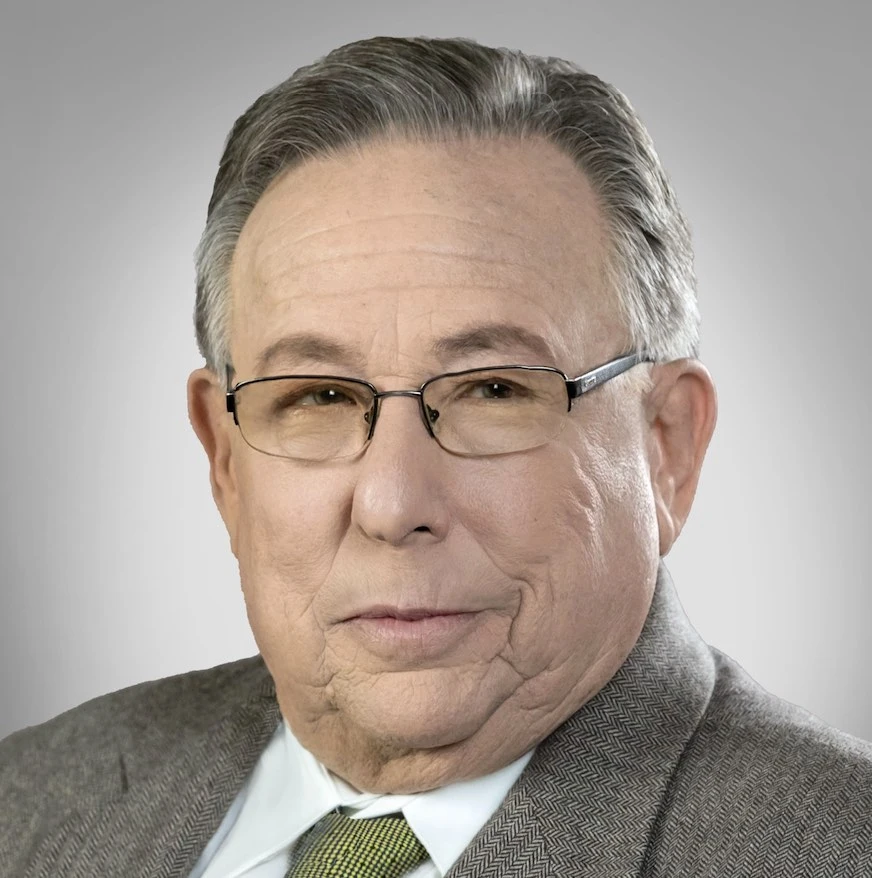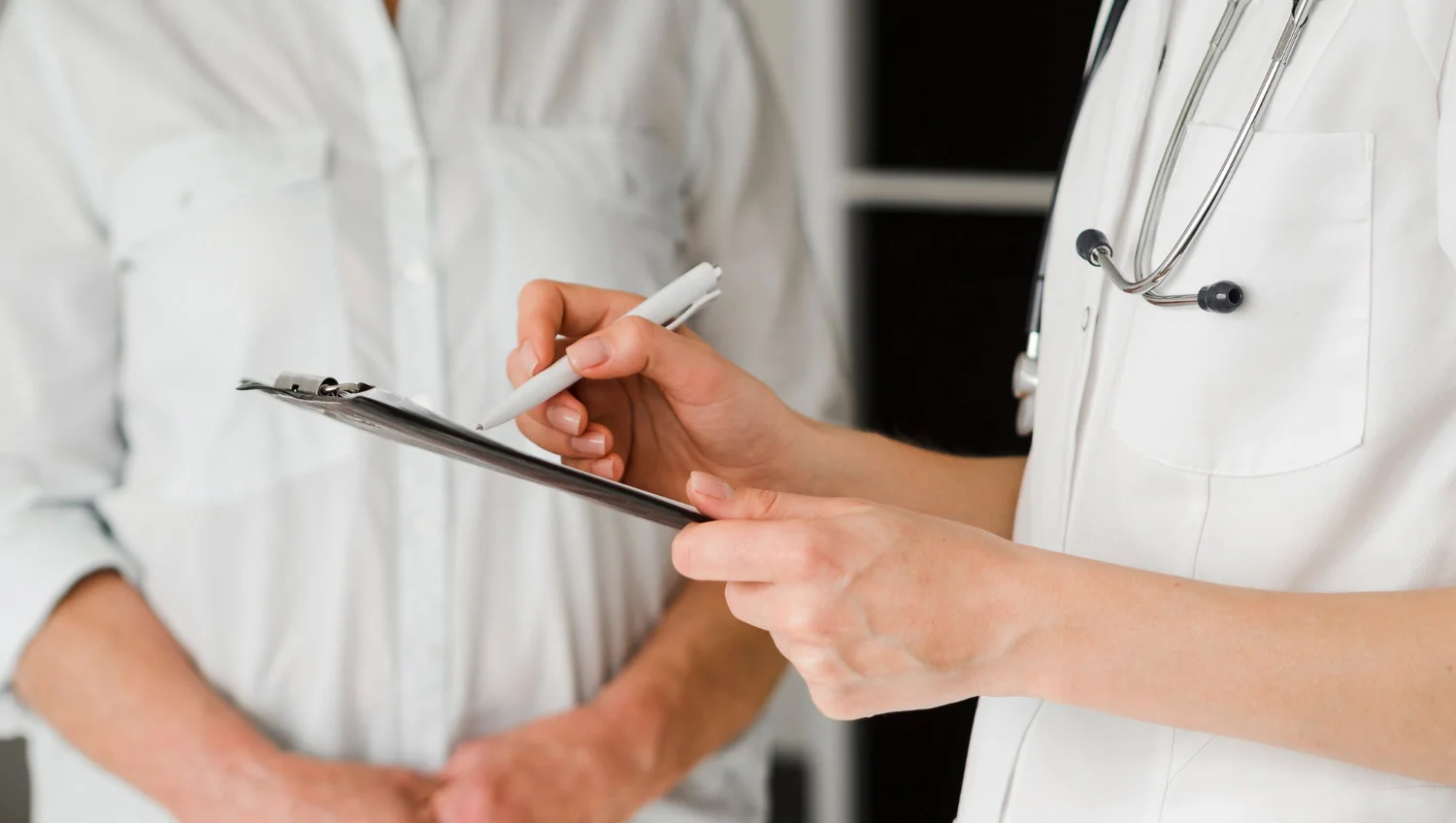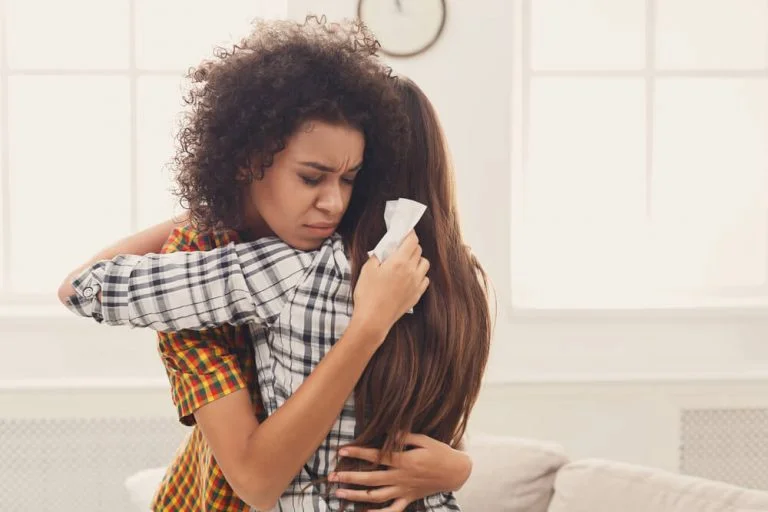What Are Recreational Drugs?
Recreational drug use is a sensitive and complex issue that many struggle with in silence. Recreational drugs are substances you consume primarily for pleasure, enjoyment, or non-medical purposes that range from legal compounds like caffeine and alcohol to illegal substances such as heroin and cocaine, potentially leading to dependency or addiction with continued use.
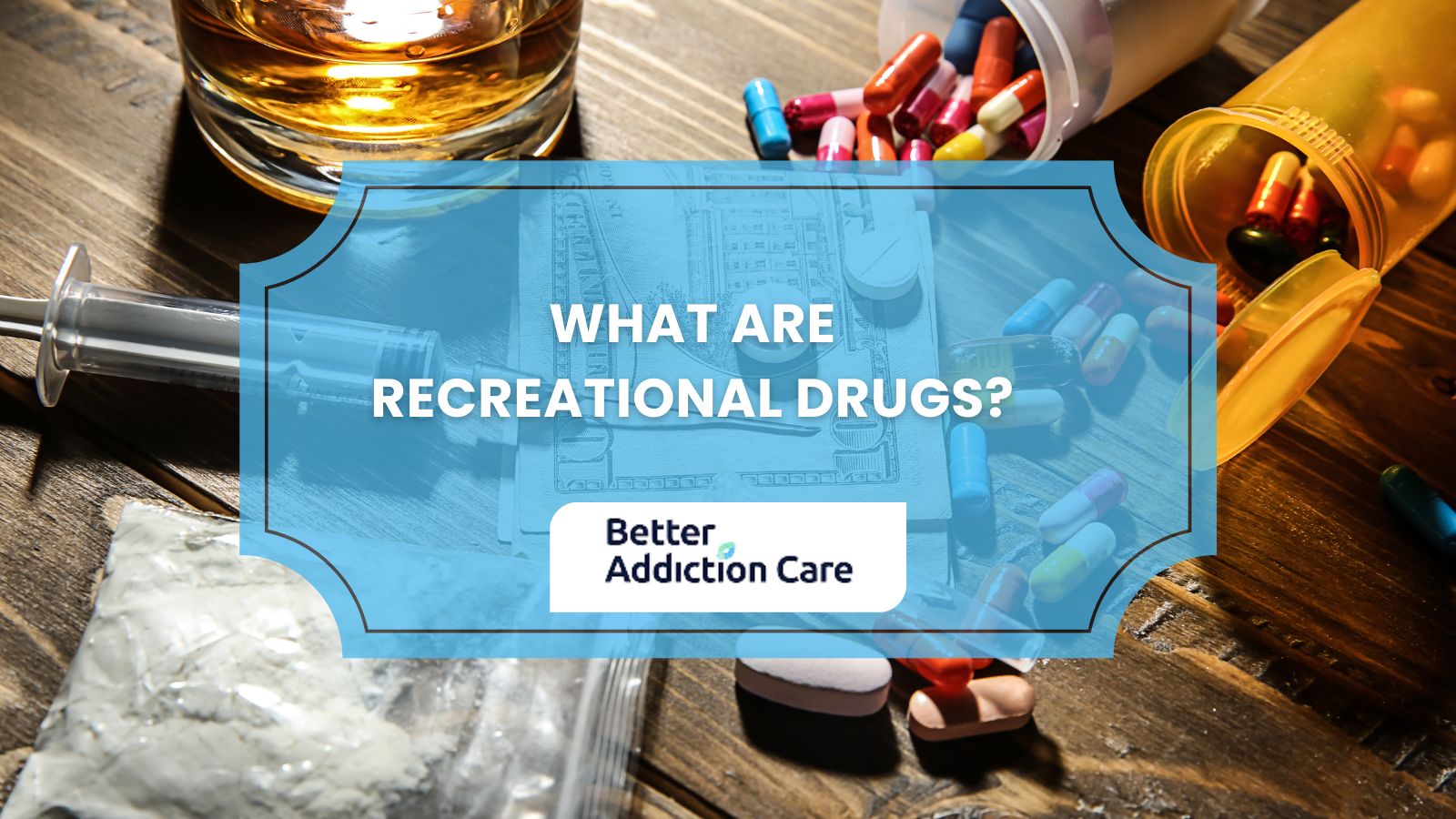
Recreational drugs include stimulants, depressants, hallucinogens, opioids, dissociatives, cannabis, and inhalants. Cannabis stands as one of the most widely used recreational drugs in the United States, with 23.0% of adults reporting past-year use, while 7.0% developed cannabis use disorder (CUD), and alarmingly, only 16.5% of those with CUD received any substance use treatment.
Recreational drug use leads to severe physical effects, mental health issues, strained relationships, and significant legal and financial consequences.
Treatment options for recreational drug addiction include rehabilitation programs, support groups, counseling, and Medication-Assisted Treatment (MAT).
What defines A Recreational Drug?
Recreational drugs are substances used voluntarily for enjoyment, pleasure, or relaxation rather than for medical purposes or health benefits. These chemical compounds affect the central nervous system, altering perception, mood, consciousness, cognition, or behavior, and are consumed primarily for their psychoactive effects.
Recreational drugs encompass a wide range of legal substances (such as alcohol, caffeine, and nicotine) and illegal substances (including cannabis in some jurisdictions, cocaine, heroin, and synthetic drugs), all of which carry varying degrees of potential for dependency, addiction, and adverse health consequences.
According to Driver, E. M.’s 2020 study, ‘Alcohol, nicotine, and caffeine consumption on a public U.S. university campus determined by wastewater-based epidemiology’, 85% of the U.S. population reports daily caffeine consumption (averaging 178 mg per day for college students), this has led to approximately 80,000 emergency room visits between 2005-2011 and 92 known caffeine-related deaths, particularly from energy drink overconsumption.
What Are Legal And Illegal Recreational Drugs?
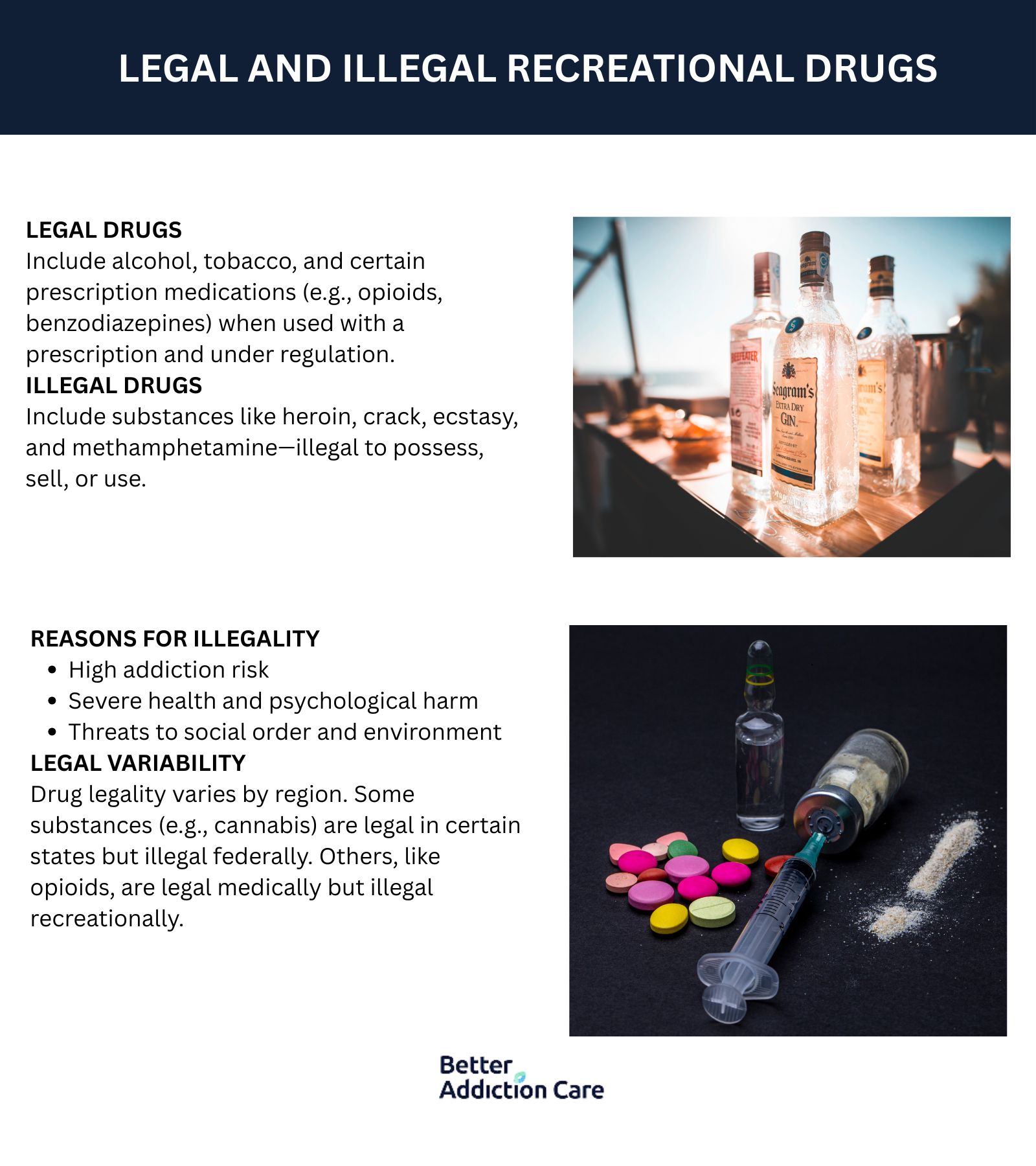
Legal recreational drugs include alcohol and tobacco, which come with restrictions on purchase, consumption, and age limits. Some prescription medications, like opioids and benzodiazepines, are used recreationally but require a doctor's prescription.
Illegal recreational drugs cannot be obtained through legitimate channels as their possession, sale, and distribution are criminally punishable. These include substances like crack, heroin, ecstasy, and methamphetamine. According to CDC data from 2019, 13.0% of persons age 12 years and older in the United States reported using illicit drugs in the past month, while 1.9% reported nonmedical use of psychotherapeutic drugs during the same time period.
Drugs are classified as illegal for several compelling reasons:
-
High potential for addiction and severe health risks
-
Perceived threats to social order
-
Environmental damage from production
-
Physical and psychological harm to users and others
The legal status of recreational drugs varies by location. Some substances are legal at the state level but illegal federally. Cannabis is increasingly becoming legal in many regions, while certain drugs have approved medical applications but remain illegal for recreational use (such as opioids).
What Are The Types of Recreational Drugs?
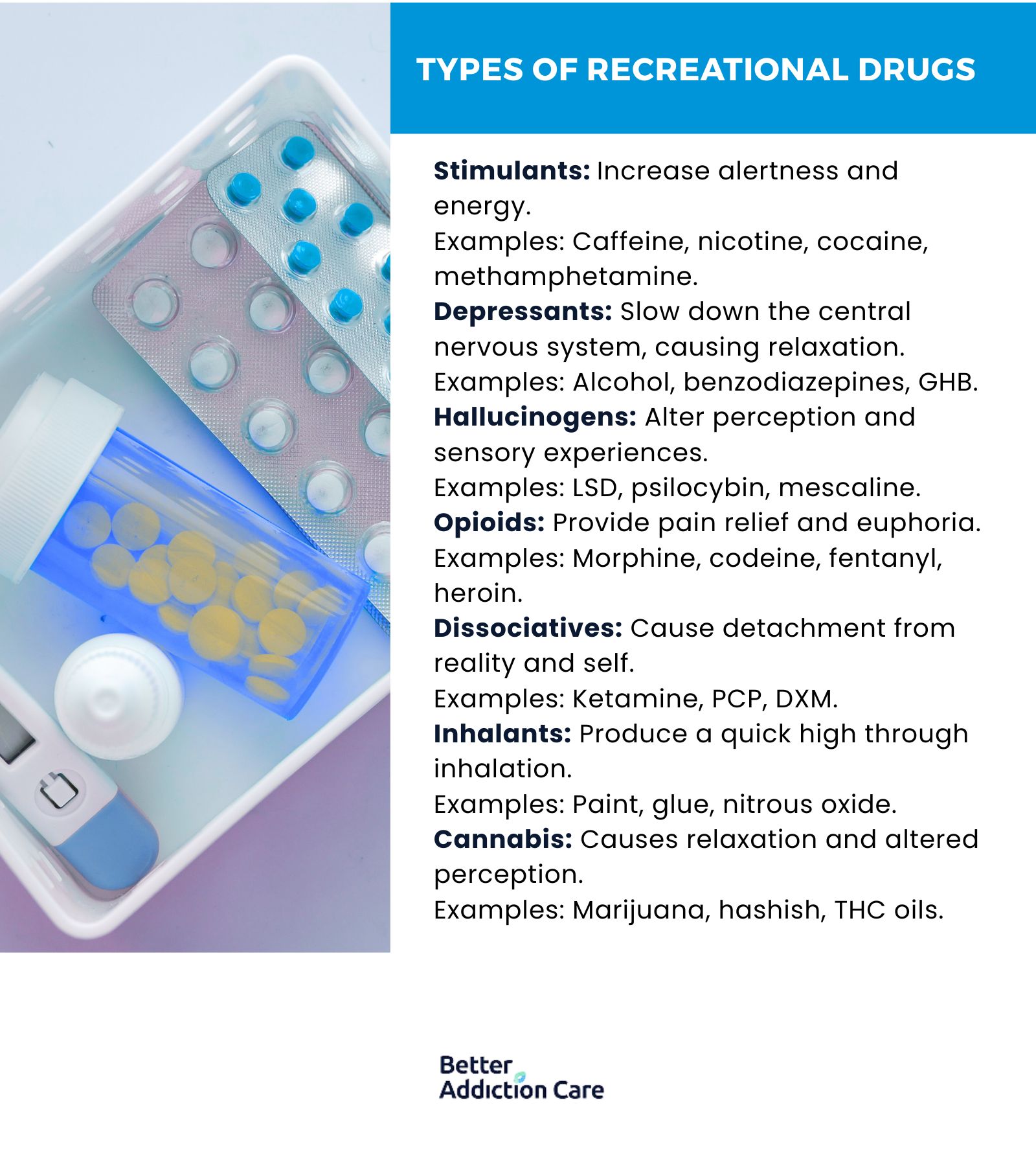
The types of recreational drugs include stimulants, depressants, hallucinogens, opioids, dissociatives, and inhalants. When you use stimulants like caffeine or cocaine, they speed up your central nervous system, while depressants such as alcohol slow it down. Hallucinogens alter your perception, opioids relieve pain but risk addiction, dissociatives create detachment from reality, and inhalants provide quick but dangerous highs from everyday products.
Here are the common types of recreational drugs:
Stimulants
Stimulants are substances that speed up your central nervous system, making you feel awake, mood-boosted, and energetic. They increase the levels of certain brain chemicals, like dopamine and norepinephrine, which regulate your feelings of pleasure, motivation, and focus.
Common examples of stimulants include caffeine, nicotine, and certain prescription medications used to treat attention deficit hyperactivity disorder (ADHD). When you consume stimulants, you often experience heightened alertness, improved concentration, and a sense of euphoria.
Legal examples include:
-
Prescription drugs like amphetamine and modafinil
-
OTC products like caffeine (coffee, tea, and soda) and nicotine (tobacco, vape juice, etc.)
Illegal stimulants include addictive substances like cocaine and methamphetamine. Party drugs that also qualify as hallucinogens, like ecstasy (MDMA), are also illegal.
Depressants
Depressants are substances that slow down your central nervous system. They are intended to make you less aroused, leading to effects such as mild relaxation, drowsiness, and even unconsciousness. Common examples of depressants include alcohol, benzodiazepines, and barbiturates. When you consume depressants, you feel calmer and more sedated. However, excessive use results in negative consequences, such as impaired coordination, slowed breathing, and increased risk of overdose.
The most common depressants include:
-
Prescription medications like benzodiazepines
-
OTC products like alcohol
-
Gamma-hydroxybutyrate (GHB), an illegal drug
-
Herbal plants like kava
Hallucinogens
Hallucinogens, commonly known as “psychedelic drugs,” are substances that alter the way your senses work, affecting your smell, sight, taste, touch, and hearing. With high enough doses, you experience true hallucinations, seeing or hearing non-existent or distorted things. Examples of hallucinogens include LSD, psilocybin (magic mushrooms), and mescaline. When you consume hallucinogens, you often enter altered states of consciousness, which lead to profound changes in perception and thought. However, these experiences are unpredictable and result in anxiety or confusion.
Opioids
Opioids are substances known for their pain-relieving effects, which is why many types are sold legally as prescription medicines. They interact with your body’s opioid receptors, helping block pain signals. Doctors usually administer opioids for cases of severe pain, including surgery recovery, cancer-associated pain, chronic headaches, and more.
Opioids include:
-
Analgesic and anesthetic synthetic substances like fentanyl
-
Prescription drugs like morphine, codeine, and oxycodone
-
Illegal substances like heroin
When you use opioids, you experience significant pain relief, but you also face risks such as dependence and addiction. Misuse of opioids leads to serious health issues, including overdose.
Dissociatives
Dissociatives alter your perception of reality by disrupting communication between different parts of the brain. They create feelings of detachment from your body, environment, or identity, often described as an "out-of-body" experience. At higher doses, they lead to hallucinations and memory loss.
Common dissociatives include:
-
Ketamine, used medically for anesthesia but is also misused recreationally.
-
PCP (phencyclidine), known for its intense and unpredictable effects.
-
DXM (dextromethorphan), found in some over-the-counter cough medicines, when taken in large doses.
Inhalants
Inhalants are substances that people breathe in to achieve a quick high. These chemicals are found in everyday household products but are dangerous or even deadly when misused. Inhalants depress the central nervous system, causing dizziness, euphoria, or unconsciousness.
Examples of inhalants include:
-
Aerosol sprays (e.g., paint, deodorant).
-
Solvents (e.g., glue, gasoline).
-
Nitrous oxide ("laughing gas"), commonly used in whipped cream dispensers or at parties.
Cannabis/Cannabinoids
Cannabis or Cannabinoids is a substance often classified separately due to its unique effects, which overlap with other categories like depressants and hallucinogens. It contains compounds such as THC (tetrahydrocannabinol) that produce psychoactive effects, including relaxation, altered perception, and heightened sensory experiences.
Additionally, cannabis includes other cannabinoids, such as CBD (cannabidiol), which does not produce psychoactive effects and is often associated with therapeutic benefits.
Forms of cannabis include:
-
Marijuana (dried flowers and leaves).
-
Hashish (concentrated resin).
-
Edibles, oils, and vapes containing THC or CBD (non-psychoactive).
What Are The Effects of Recreational Drug Use?
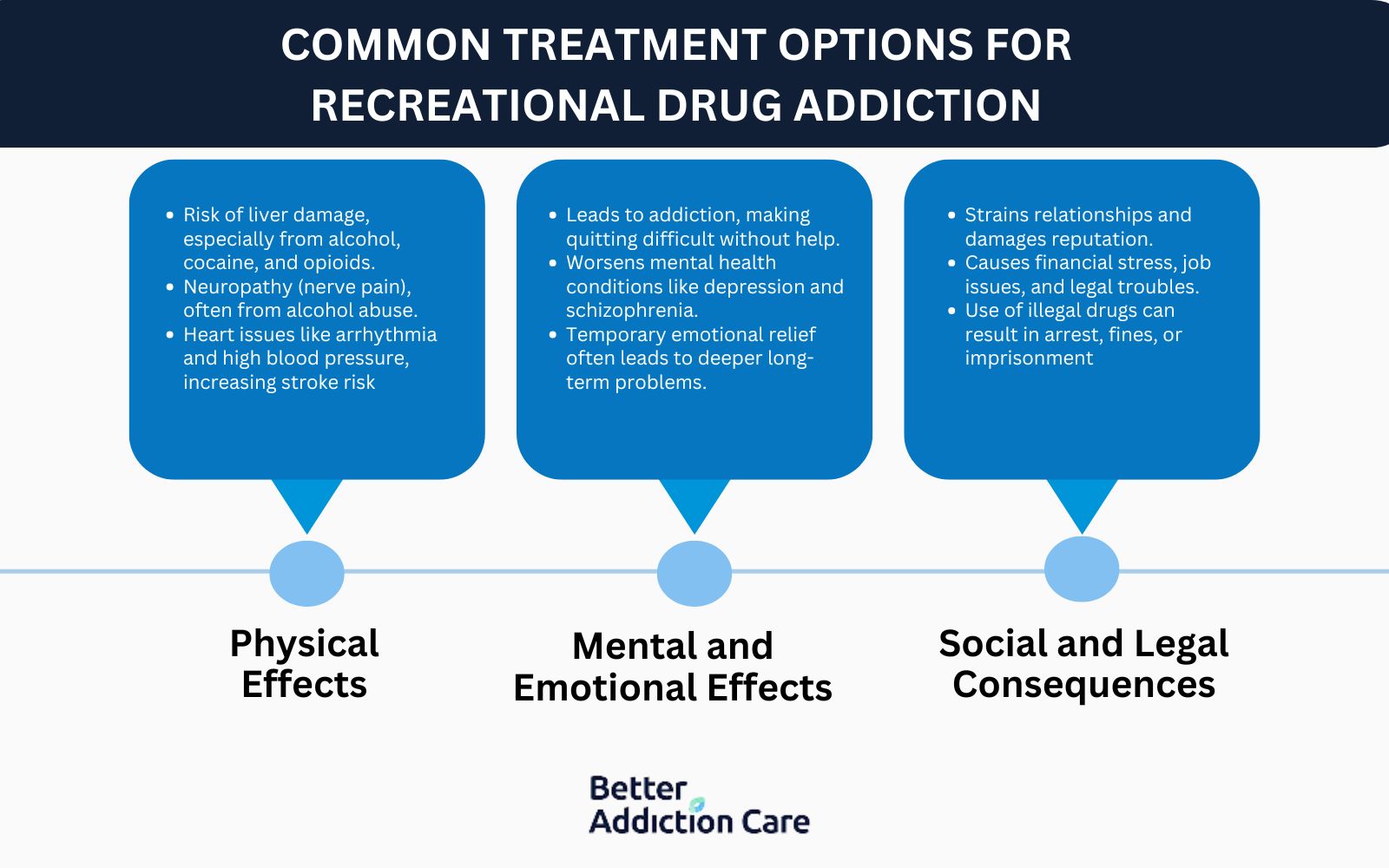
The effects and risks of recreational drug use include physical damage to organs, addiction, mental health deterioration, strained relationships, and legal consequences. Substances harm the liver, cause nerve damage, create heart problems, and increase stroke risk. Drug use worsens existing mental health conditions, creates financial burdens, and results in criminal charges.
Here are the key effects of recreational drug use:
Physical Effects
Physical effects of recreational drug use is severe and far-reaching. Continued, uncontrolled use of recreational drugs puts you at risk for liver damage. Alcohol, cocaine, and opioids cause liver injury. Neuropathy, or painful nerve damage, occurs with substance abuse. Alcohol abuse leads to alcoholic neuropathy, resulting in pain and burning in the feet and legs.
Recreational drugs, particularly stimulants, cause cardiac arrhythmia, or irregular heart rate. Stimulants create excitement, heightened alertness, and euphoria. These effects increase blood pressure, which raises your risk of stroke.
Mental and Emotional Effects
The mental and emotional effects of recreational drugs are significant and often lead to addiction, whether due to your intake habits or the nature of the drug itself. For example, heroin is highly addictive, and your body and mind continuously long for it. Overcoming drug addiction proves challenging without professional intervention.
If you experience mental health issues, recreational drug use aggravates your symptoms and leads to conditions such as depression and schizophrenia. Using alcohol as a way to escape your problems temporarily exemplifies this. Engaging in recreational drug use complicates your mental and emotional well-being, making it essential to seek help if you struggle.
Social and Legal Consequences
Social and legal consequences of recreational drug use are significant and far-reaching. Engaging in drug use, addiction, and withdrawal symptoms often strains your relationships with family, friends, and the community. Some drugs alter your thinking, make you hypersensitive, and even lead to hallucinations. As a result, you engage in behaviors that those around you do not take lightly.
Addiction to drugs creates a financial burden over time. In addition to affecting your spending habits, drug use leads to job performance issues. If you get caught possessing illegal drugs, the legal handling fees become another expense you must bear.
Most recreational drugs are illegal. Engaging in DUI, criminal activity, or distribution results in severe repercussions. Overall, the social and legal ramifications of recreational drug use have lasting impacts on your life and well-being.
What Are The Treatment Options for Recreational Drug Addiction?
The treatment options for recreational drug addiction include rehabilitation programs, support groups with counseling, and medication-assisted treatments, all providing different levels of care based on individual needs.
Here are the common treatment options for recreational drug addiction:
Rehabilitation Programs
Rehabilitation programs are structured treatment options designed to help you overcome drug addiction, providing compassionate support and care throughout your recovery journey. Many local clinics, hospitals, and behavioral counselors offer both inpatient and outpatient rehab options tailored to meet your specific needs.
Inpatient care allows you to stay in hospitals and treatment centers, where you receive comprehensive assessments, therapies, and appropriate medical attention.
The benefits of inpatient rehab programs include:
-
Having your basic necessities taken care of, allowing you to focus entirely on your recovery
-
A safe distance from triggers that lead to addictive behaviors
-
Intensive support, both medically and emotionally, from dedicated staff and fellow patients who understand what you are going through
If you prefer a more flexible approach, outpatient rehab offers an alternative that might suit your lifestyle better. You access necessary resources for sobriety while maintaining daily routines, such as staying at home, attending school, or working. Many programs schedule sessions during evenings and weekends, allowing you to balance personal responsibilities with essential support.
Support Groups and Counseling
Support groups and counseling are essential resources that aid in your recovery from addiction. These groups connect you with others in your community facing similar challenges, providing a sense of belonging and understanding.
While not a standalone solution, support groups complement other rehabilitation programs. They create a supportive environment that enhances your recovery journey. Engaging with others who share your experiences empowers you and offers valuable encouragement as you work toward healing and growth.
Medication-Assisted Treatment
Medication-Assisted Treatment (MAT) is an effective first-line approach for drug addiction, especially when combined with counseling and therapy. Specific medications, such as methadone and buprenorphine, are used to treat opioid addiction, including heroin.
However, no medications have been approved by the Food and Drug Administration for treating addiction related to cannabis and other stimulants. MAT provides a valuable tool in the recovery process, helping to manage withdrawal symptoms and cravings while supporting overall treatment efforts.
What Are Some Resources for Individuals Struggling with Recreational Drug Use?
Some resources for individuals struggling with recreational drug use are available nationwide through helplines and crisis support services. Taking the step to seek help is an essential part of the recovery journey.
National Helplines and Hotlines:
-
For emergencies: Call 911 for immediate assistance
-
For mental health crises, the 988 Suicide & Crisis Lifeline is available 24/7
-
For poison-related emergencies, 1-800-222-1222 connects to poison control centers
For finding drug addiction treatment programs:
-
SAMHSA National Helpline: 1-800-662-HELP (4357) offers confidential, free, 24/7/365 treatment referral and information services for individuals facing substance use disorders.
How to Find Local Drug and Alcohol Facilities for Recreational Drugs Abuse?
To find local drug and alcohol rehab centers near you for recreational drugs abuse, start by researching facilities specializing in substance use disorders. Consult your primary care physician for referrals, use SAMHSA's treatment locator tool, or check online directories with patient reviews. Contact your health insurance provider to identify in-network options that reduce costs.
We connect individuals with appropriate treatment centers nationwide. Our specialists evaluate your specific needs and match you with local drug and alcohol rehab facilities offering evidence-based therapies that address the physical, psychological, and social aspects of addiction while providing free insurance verification and confidential support throughout recovery.

